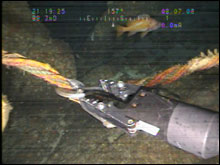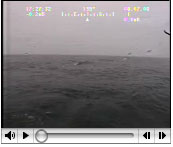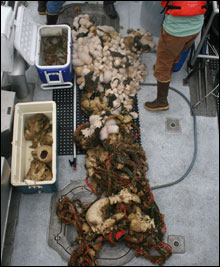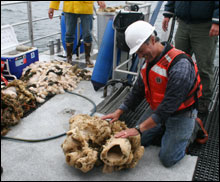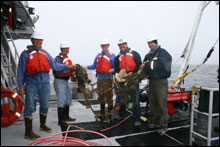 | |||||||||||||||||||
|
|
|
|
|
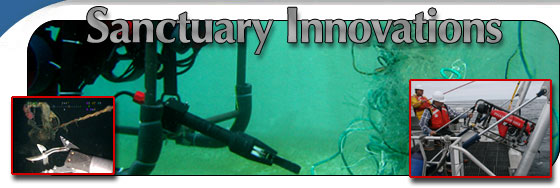
Our marine technician worked late into the night modifying the cutting head on the ROV’s manipulator arm and we are anxious to see how it works. Yesterday, we were not able to cut through the tangled mass of multiple lines, we are hoping for a different outcome today. Unanticipated challenges are part of working in the field, and often times the success of a cruise depends on how you respond to those challenges. The one challenge out of our control, the weather, is cooperating nicely as we cruise over gentle two to four foot swells on our way out to the bank. We decided to stick with the same strategy as yesterday, start easy and progress to the more difficult. We selected as our first target of the day a single long line entangled in moderately large boulders in 230 feet of water. Successfully relocating the long line, the ROV pilot expertly maneuvered the vehicle into position. As the blades of the cutting shears slid above and below the line, the science team collectively held their breath, and then, the blades sliced through the line like a “knife through butter”. A cheer went up in the room - the cutting tool worked like a champ and we were ready for more. Now it was a matter of following the line along the seafloor and finding a spot where we could make another cut. After the second cut was made without any problems, the pilot grabbed the loose piece of long line with the manipulator arm and brought the gear to the surface with the ROV. The old gear was brought on board, and after a short celebration, we put the line in a tub with running seawater to keep the attached animals alive. Confident that our new cutting head worked better than the old one, we headed back to the gill net we were not able to retrieve yesterday, which is located in 250 feet of water. Gill nets have floats on a top line (float line) and weights on a bottom line (lead line) with mesh netting stretched between. When the gear gets tangled on the bottom and lost, the floats buoy the netting up so it is suspended off the bottom and into the water column. Removing the gill nets is a more difficult task. The net is a twisted mass of multiple lines and netting suspended in the water column. After surveying the situation, the ROV pilot moves the ROV into position to make his first cut. This time it takes a little longer because we are cutting through multiple lines. Similar to the long line, this gill net is tangled in two places so we need to make two cuts. With the last cut, the gill net is free. Because it is positively buoyant, it rapidly ascends to the surface and is brought onboard. We have successfully removed a gill net from deep water on Cordell Bank. With the right tool, it was pretty straight forward, but much credit goes to the pilot who made it all look pretty easy.
We are amazed at the sea life that is encrusting the net. It is alive with brittle stars, sponges, tunicates, small rock scallops and skeleton shrimp otherwise known as caprellid amphipods. We quickly put the gear into our live tanks and discuss our next target. After a short consultation, we decide to go after the gnarliest piece of gear we have seen. It is a large mass of a gill net that extends about 50 feet up into the water column. Motoring across the bank to our next location, I marvel at how technology allows us to find a “needle in a haystack” or a gill net in the ocean. We reach our destination, the northwest corner of Cordell Bank, and deploy the ROV overboard in 280 feet of water. When trying to relocate the gear, the first thing we saw in the distance was a white hue up in the water column. As we approached the gear, we realized that we were looking at white-plumed anemones that have settled on the gear that is swaying in the water column. The net is heavily encrusted and has likely been on the bottom for over 20 years.
Finally with the last snip, the gear is freed from the bottom and begins a slow rise to the surface. The crew in the control area lets out a cheer - mission accomplished. Because of all the growth on the net it does not surface immediately and observers line the deck looking for the gear. One of the crew members lets out a shout and there off our starboard bow is the floating mass of gear. This is a bonanza. The netting was nearly 50 feet long and encrusted with a host of organisms. It took teamwork and a little elbow grease to haul the net onboard.
The net is covered with white-plumed and strawberry anemones, crabs, worms, tunicates and some very large vase sponges. This net has been down for a while. We carefully place the organisms into our live tanks and realize that we are going to exceed our holding capacity if we remove any more gear. Because this is such a unique opportunity for us to collect specimens along with the gear, we decide to call it a day. We will need to talk with our partners in local aquariums to find a place for all of these organisms.
|
|
||||||||||||||
|
|||||||||||||||||||




